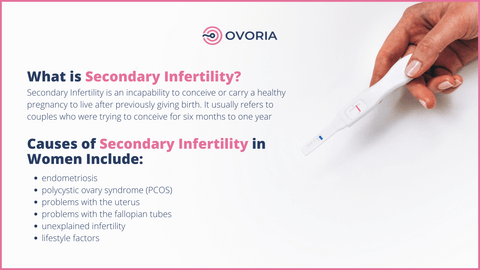Secondary Infertility
There is a common misconception that if women get pregnant once, they can not experience any difficulty getting pregnant again and have a successful pregnancy. That is not true. The concept of primary and secondary infertility is thus significantly less known. It is not unusual for fertility problems to be encountered when trying to have a baby for the second or third time, or about couples are experiencing secondary infertility when trying to decide whether to stop trying?

According to National Infertility Association, secondary Infertility is an incapability to conceive or carry a healthy pregnancy to live after previously giving birth. It usually refers to couples who were trying to conceive for six months to one year.

The Most Common Causes of Secondary Infertility
Some factors can lead to secondary fertility. This condition can be also common in male infertility and female infertility. Although many things can lead to this condition, the most common are:
Endometriosis: Endometriosis is a condition where tissue that usually grows inside the uterus grows elsewhere. While endometriosis is expected, not all endometriosis causes female infertility.
Polycystic Ovary Syndrome: PCOS is a hormonal condition caused by an excess of male hormones and a deficiency of female hormones. A lack of ovulation characterizes it because of the imbalance in male and female hormones. A woman who has polycystic ovaries does not ovulate or does not ovulate regularly. They also have an excess production of androgen, which is the male hormone.
Problems with the uterus: It's also common to find uterine fibroids and endometrial polyps in older women. Not only can these affect a woman's fertility, but previous miscarriage is an essential factor that might prevent her from getting pregnant again.
Problems with the fallopian tubes: The fallopian lines, which carry eggs from the ovaries to the uterus, can become blocked due to pelvic infections such as chlamydia or gonorrhoea.
Egg Reserve: The number of eggs in the ovaries is called egg reserve. The quality of the eggs goes down with age, leading to a lower chance of getting pregnant.
Unexplained infertility: it s the most common type of infertility women could face. It's responsible for around 30% of infertility cases. Even after primary infertility medical tests are carried out, the source of infertility remains a secret.
Lifestyle changes: According to a study, a certain percentage of women have had their ovary function affected by weight gain. A study found that specific diets may affect fertility. Medications may also affect fertility.
Woman Ages:
You and your partner are both older. Since you last got pregnant, your ovarian reserve could be drained, and the more aged you are, the more difference a year can make. Age is a common factor in female infertility.
Treatments for Secondary Infertility
Secondary infertility treatments work in the same way as with primary infertility. The fertility doctor can put you on prescriptive drugs to enhance your ovulation. Artificial insemination or IUI may be recommended as a treatment options for overcoming fertility issues or IVF.
In-Vitro Fertilization (IVF): For many couples, IVF treatment could open up many different options. Through IVF treatment, eggs are fertilised with sperm outside the body which develops into an embryo transferred directly into the uterus.
Intrauterine Insemination (IUI): The sperm is extracted from the male partner or donor. The sperm is put into the female's uterine cavity during ovulation. This makes the sperm available close to the fallopian tubes, where it could quickly meet the egg for fertilisation.
Intracytoplasmic Sperm Injection (ICSI): ICSI can be considered when a man has poor sperm count, poor morphology, and even in cases of poor motility. ICSI often has a high fertilisation rate.
Infertility Drugs: Common oral medicines like Clomiphene Citrate and Letrozole, which stimulate the ovarian follicles to release more eggs, are also utilised to provoke the growth of matured eggs in one egg retrieval cycle.
How can Secondary Infertility be Diagnosed?
Secondary infertility is the failure to produce a child after a past successful birth, even after several attempts. As mentioned by the World Health Organization (WHO), infertility means the inability of a person to produce a child following at least a year of unprotected intercourse.
Secondary infertility happens when a person has at least one child or has had at least one successful or failed conception but has difficulty getting another, as opposed to primary infertility, which happens when someone is having issues in having the first child. Since fertility decreases as we age, many couples wait until their 30s to have kids.
However, if a family has had their first child in their 30s and remains another few years to have another kid, it might not be problematic.
References:

